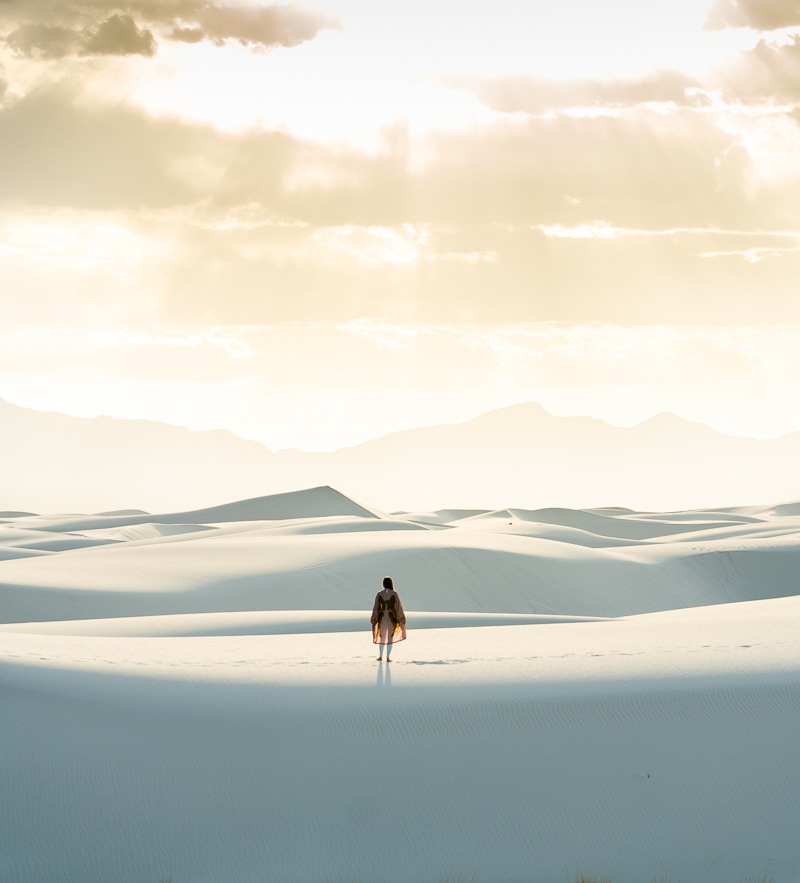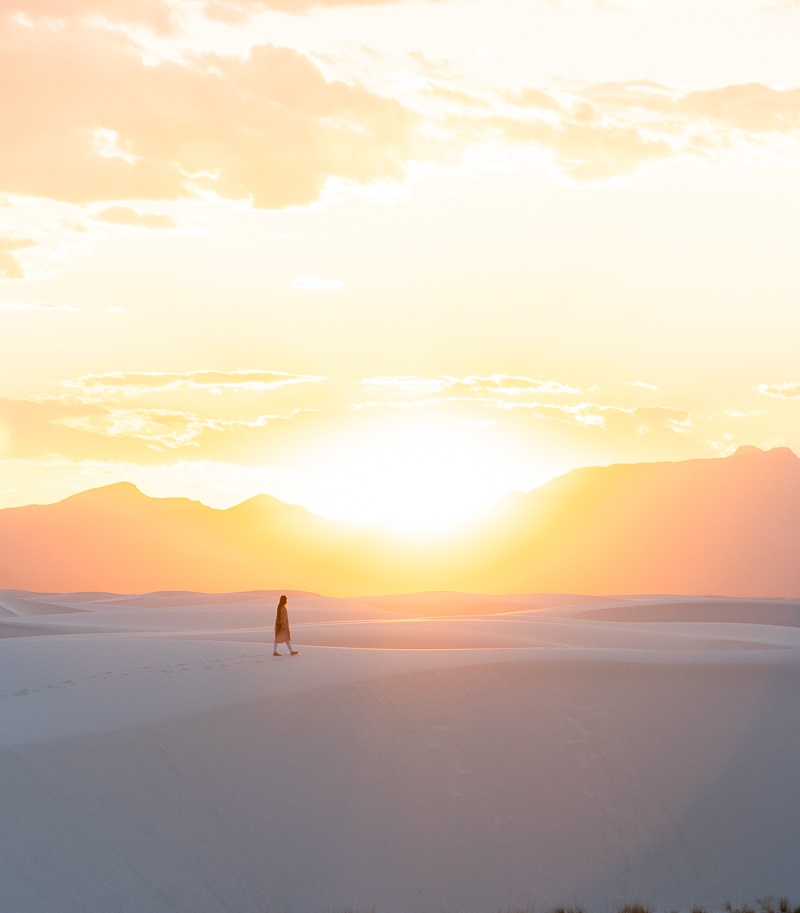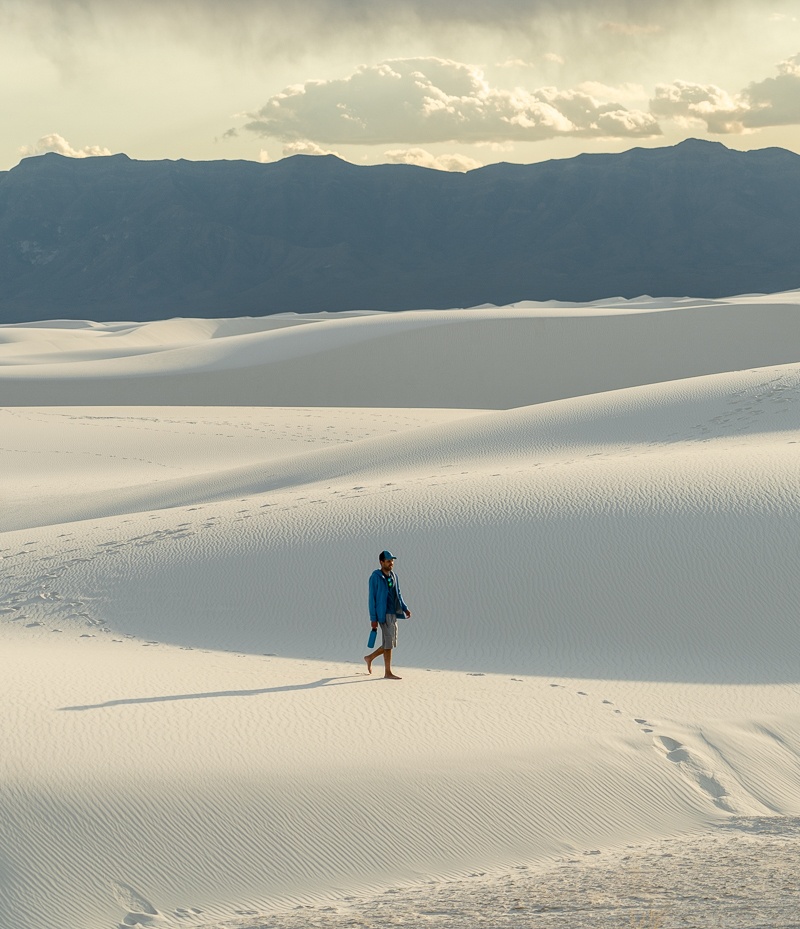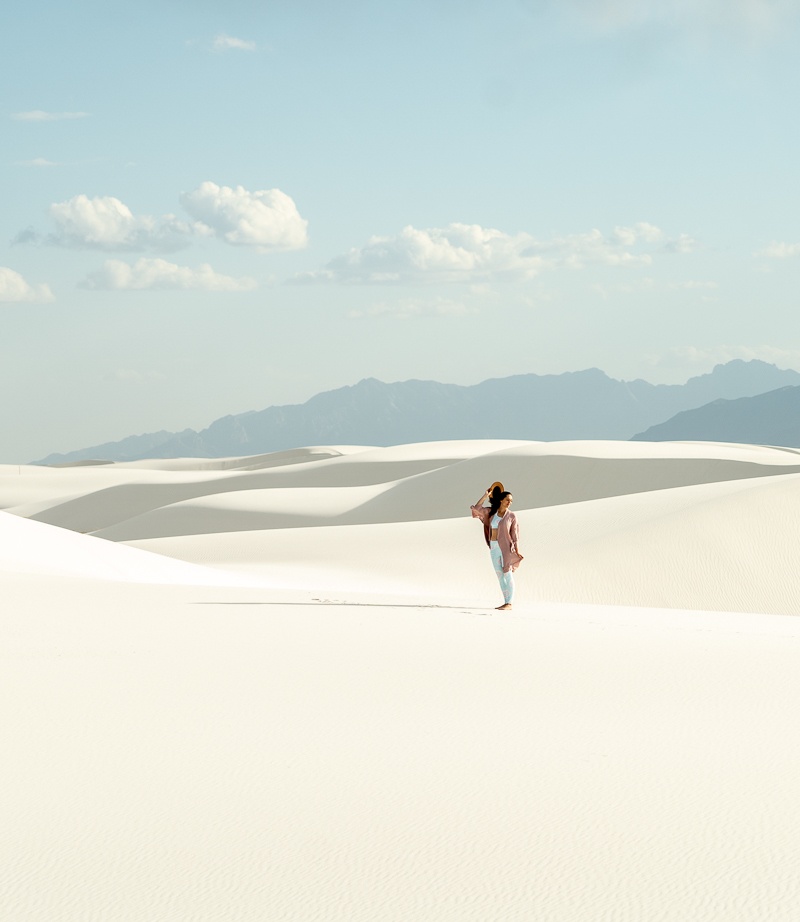White Sands National Park is just as magical as you imagine it will be. It’s one a few places that I built up in my mind that actually lived up to my expectations. And although it’s in the middle of nowhere, and you will most certainly be making a big detour to see it, it is worth it!
There are a few essential things that will make your visit that much better, so let’s dive in!
Go for Golden Hour/Sunset

Although White Sands National Park is impressive at any time of day, it’s the couple of hours before sunset that it comes alive with color – yes, color! This is when you’ll see shadows in some of the dunes, the sun casting patterns on them as it sets. If you’re lucky, there will be some clouds in the sky to create even more contrast.
The best way to photograph this is with a zoom lens and to have your subject facing west with the sun behind them.
Even if you’re not a photographer, be sure to stay for the sunset, because it is spectacular over those white dunes!
Also keep in mind that the afternoon can be quite windy in the spring, which is when I went. However we did get lucky and the wind completely subsided for the sunset. If you have a camper van or car that won’t drain the battery with an open trunk or something similar to hang out in to wait out the wind, you’ll be happier!
Bring a Sled/Saucer!
Sledding down the dunes is part of what makes White Sands so much fun, especially for kiddos (you can bring dogs, too!).
The best apparatus is a snow saucer, the kind you used as a kid. It’ll go faster if you wax the underside! And don’t worry, this is condoned by the national park. They even have sleds that you can rent if you can’t find one to bring with you!
We lucked out because our Airbnb had some saucers that we could use, but we also noticed that people left them behind at the picnic area for others to use.
So find the tallest dune you can, and lean back to slide faster!
Check Opening Hours First

Most national parks are open 24/7, however White Sands is not. It’s usually open for the sunset, and it will often stay open later during the full moon.
I believe this is because that national park is actually within a missile range owned by the US military.
However it is possible to get a permit to camp in the dunes overnight. At the moment due to Covid, they are not available, but hopefully in the future it will be possible again. I can just imagine how stunning the stars would be out there!
Check current park hours and closures here.
Drive to the End and Face West

As national parks go, I did not find White Sands to be very crowded. You don’t have to go far to get your own dune.
I recommend driving to the end of the road at the loop and walking west on the dunes. We did so from one of the picnic areas and that’s how we got all of the photos that you see here. You will see some accessible walking trails and other options earlier on in the park, but the farther in you get the more the dunes are basically one big trail and there is no set route.
For this reason, it’s imperative that you leave no trace, and that you orient yourself so that you don’t get lost! I recommend downloading maps.me, which is a free offline map app, before you go so that you can drop a pin where you park to navigate back to.
We mainly used the sun to orient, but you’ve got to be a bit more experienced with navigation order for that to work.
Bring Water, Food, and Sunscreen

Once you pass the visitor center at the very beginning of the park entrance, there will no longer be any services. This means that you will not be able to refill water, will not be able to buy snacks, food, or sunscreen anywhere, although there will be bathrooms every now and then.
Many national parks are like Disneyland in that it’s simple to stay on the trail and to know where you are at all times. White Sands is not like that, and you need more preparation to enjoy it. I loved that it was so much more wild and that we were free to explore, but that might not be for everyone.
Make sure that you bring a hat for the sun, sunscreen, and all of the water and food that you will need.
The Only Shelter is the Picnic Area
In case you do need some respite from the sun, there are picnic areas along the drive into the park that offer shade. If it happens to be crazy windy like it was the afternoon that I went, these aren’t going to be that helpful because you’ll be pelted with sand while you try to eat. In most other seasons that are less windy I imagine it’s nice to hang out in there while you eat lunch.
Otherwise, there are no trees, or shade, to speak of.
Know the Vastness and the Animals You’ll Share Space With

This is the worlds largest gypsum in sand dune field spanning 275 miles in the middle of the desert. It might seem like it would desolate, with no vegetation or animals, but that’s not true! There’s a water table directly under the sand, and if you dig a bit under the surface at the low points you will find that the sand is wet!
This means that you will find wildlife out there, including three kinds of rattlesnakes and scorpions. I still walked around barefoot, as this is the easiest way to climb dunes, and had no problem. I only bring this up so that you know to be aware.
Also keep in mind that the desert is a fragile ecosystem, and it’s important to not step on plants, and to leave the most fertile dunes with lots of vegetation alone.
If you’re lucky and you’re visiting in the spring, you’ll see the Purple Sand Verbena in bloom. This plant was used by American Indians as a mild sedative, which had a calming effect and was useful in reducing nervousness, anxiety, and tension. Give it a sniff, it smells just like gardenia!
My experience at White Sands National Park was one I will never forget. The way that the sun hit the dunes, and the abundance of plants out there was amazing to me. This is truly one of the natural wonders of the world, and we are so lucky to have it in the USA!
Pin me for later:


Miles with McConkey says
Great post! We visited White Sands National Park a few days ago. We absolutely loved it! I must admit it is a bit surreal to see such a vast area of white sand with no ocean in sight. The white dunes are breathtaking against the blue sky. There were lots of visitors but we never felt cramped for space.
It is pretty easy to find open dunes for sledding. A ranger advised us to head toward the back of the park (mile markers 6 to 8) right away. She said that we may beat some of the crowd and the best dunes for sledding are in the back. Part of the reason for this is that there is much more vegetation on the dunes in the first 4 or 5 miles of the main road. So, you can have cleaner sledding toward the back of the park.
Wildlife sightings are better toward the front of the park due to the vegetation. With that said, the ranger jokingly told us that she had only seen two roadrunners in the past 5 months.
It appeared that there were two types of visitors at the park. 1) Serious hikers looking to tackle the Alkali Flat Trail. 2) Those seeking a casual play day at the beach. Families were sledding and digging in the sand. Lots of people were taking photographs. All of this happened while others passed by in hiking gear, looking to climb up and down the steep dunes. The contradiction was a bit comical.
You are correct that there is very little protection from the sun. Folks should definitely pack sunscreen and plenty of water to stay hydrated. It is often windy there as well. Whether you are hiking or playing, it can be quite exhausting just to walk up and down the sand dunes. The sun and wind add to this. So, drinking lots of water will help make sure you enjoy the park. The good news is that they have restroom facilities at each and every point of interest along the main road.
We found the beauty of the park to be well worth our time. We would definitely like to return for another visit in the future.
Kristin says
Glad you had fun! Thanks for sharing the extra tips.
John Mink says
If you have to be out of the park by sunset if not camping , how do you take photos at sunset?
Kristin Addis says
You have to be out by sun-down.